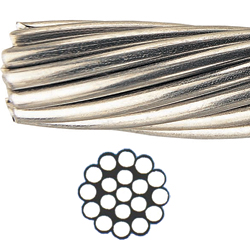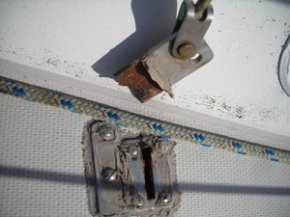
Stainless Marine Fittings
 By Tom stress
By Tom stress
Stainless steel is an alloy which has at least 50percent metal and 10per cent chromium, which prevents deterioration. The more chromium, the greater corrosion-resistance, as much as at the most about 30percent. A number of other elements are put into enhance the durability properties of a specific class and style of stainless-steel.
Type 302, 304 and 18-8
Metal alloys are grouped in accordance with the structure of these crystals. Including nickel creates austenitic stainless steels, identified by their particular 300-series designation and found in marine applications. Types 302 and 304 stainless are trusted for rigging, fasteners, accessories and propeller shafts. Type 302 is a general-purpose corrosion-resistant stainless steel with great energy properties. Many stainless created these days is Type 304, a low-carbon variation of 302, also referred to as 18-8 as it’s manufactured from 18percent chromium and 8per cent nickel. There are many 304 sub-alloys created for certain programs, fulfilling a broad demand for adequate overall performance at an affordable outlay. But there are certain marine programs in which 304 along with other 300-series types are insufficient. As an example, 303, containing sulfur or selenium for easy machining, has actually poor corrosion opposition into the marine environment.
Additional corrosion weight: kind 316
By adding even more nickel and 2-3per cent molybdenum to 304 stainless, you can get Type 316, which has the most effective corrosion resistance among standard stainless steels. It resists pitting and corrosion by most chemicals, and is particularly resistant to saltwater deterioration. There is a trade-off, however. Type 316 is only about 85per cent as powerful as 302 or 304. One of the better austenitic stainless alloys for rigging would be the “super stainless” alternatives: Nitronic 50 (also known as 22-15-5, with twice the effectiveness of Type 316 and used in pole rigging from Navtec) and Aquamet 22, that is frequently found in propeller shafts and consist of nitrogen and vanadium. Their particular “super” condition is, naturally, mirrored inside their cost.
Passivation
When metal is produced, the chromium forms an outer oxide level. Provided that layer stays intact, the stainless continues to be passive. To prevent corrosion, the passivated stainless-steel is immersed in a heated shower of phosphates or salts. This option forms an oxide film that seals off the iron, stopping it from going into option in water. Once the oxide level begins to digest, the stainless becomes energetic and its particular corrosion weight is decreased. Rust could be the obvious, noticeable proof of corrosive task.
There are a variety of ways the oxide level is compromised. These generally include pitting and crevice corrosion caused by microscopic water-retaining cracks or scratches, microscopic impurities, galvanic deterioration, deterioration weakness and stress fatigue breaking. For rod rigging, corrosion weakness could be the biggest adversary. Stress on rod rigging is concentrated at the rod head, which ultimately suffers hidden cracks without disassembling the rig, so failure is hard to anticipate. In line rigging, the stainless wire is at the mercy of stress and fatiguing whenever the watercraft moves which, over a 10-year normal lifespan, adds up to actually an incredible number of stresses regarding the rig. The insides both of the reduced terminals of swaged-on fixtures and of barrel-type turnbuckles collect water. The deterioration that results will likely be invisible or tough to detect. Regrettably, a failure may be the very first indication that your particular stainless is deteriorating.
 Sizing a sort 316 rig
Sizing a sort 316 rig
Rigs constructed of 316 stainless will generally speaking outlive those built of 302 or 304, especially in cozy tropical waters, in which saltwater deterioration is a solid adversary. In the event that you select 316, give consideration to upping your wire one dimensions in order to make up for reduction in energy. But cost very carefully. Upgrading one size in wire increase your rigging energy 15-16percent, however your expense may increase exponentially, considering that the wire itself is perhaps not the high priced area of the bargain. The bigger turnbuckles, jaws, eyes, clevis pins, etc. required because of the larger diameter wire can ruin your budget.
Here are the effects of neglect: damaged top part of upper shroud chainplate dangles from the toggle above the deck of this Catalina 30. Cover plate in the deck (alongside another non-standard two-hole tang from a DIY fix in the past) is slathered in grey sealant.
Crevice Corrosion—a classic example
The storyline you are about to review does work. The names have already been omitted to protect the responsible.
We were assisting our friends check out their particular rebuilt Atomic Four motor on the 1976 Catalina 30 on a fantastic February time on San Francisco Bay—15 knots of wind, marvelous, bright sunlight, 62° heat, two-foot cut. The motor purred like a kitten once we motored out-of Coyote Point Harbor, raised the key and unfurled the jib.
We slice the motor and sailed quickly along for a few minutes on a beam reach, and began grinding into the jib from the Barient winch to go up onto a beat. Let’s see how she would go to windward! Suddenly, there is a loud BANG and, finding out about, we saw the utmost effective area of the mast bending alarmingly to leeward, resembling the rig on our Laser. Holy cow!
Fast and decisive action, along side a telephone pole mast, permitted united states to save lots of the rig. We blew the sheets, moved head-to-wind, roller-furled the genoa, restarted the Atomic and lowered the mainsail. Only then did we spot the bottom of the port top shroud dangling limp because of the turnbuckle swinging and clanging about.
The travel back into the slip had been drama-free. The cold beers within dock were many welcome!
The scene regarding the crime: you can see the way the water got in at the top of the chainplate. The owners of this watercraft thought their rig was at sound condition! Rust never sleeps (to quote Neil teenage). Images: Ann Levine
This is a classic situation of crevice deterioration occurring in an oxygen-starved environment, concealed under the sealant. Any time you tack, the chainplate flexes very slightly relative to the deck it passes through. This small motion breaks down the bond between your sealant while the chainplate, permitting salt water, having its corrosive chloride content, to enter, be held there, and do its dastardly harm.

















